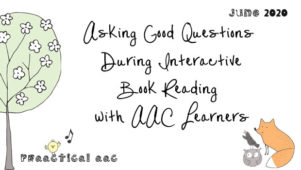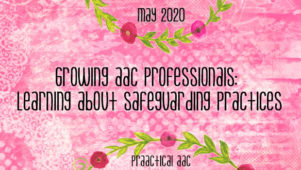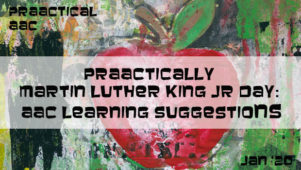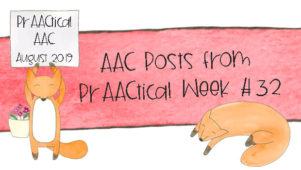AACtual Therapy: Informal Assessment Activity with Jeanne Tuthill
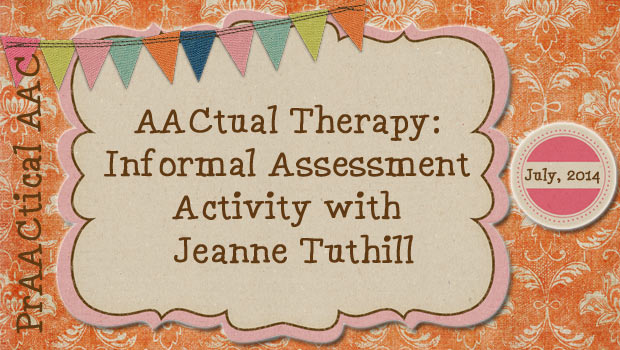
We are so pleased to have a return visit by SLP Jeanne Tuthill. In this post, she shares an informal assessment activity based around a Book of 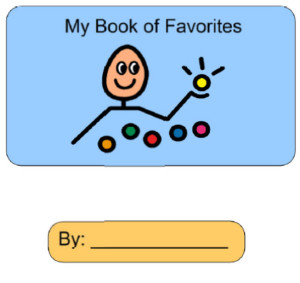 Favorites. Enjoy!
Favorites. Enjoy!
:::::::::::::::::::::::::::::::::::::::::::::::::::::::::::::::::::::::::
Greetings from Massachusetts!
My work at the Collaborative for Educational Services is on a school-year contract so I’m currently on summer break with my three girls. We’ve been plenty busy with fun summer activities but my learning and growing as an AAC therapist isn’t tied to my contract dates. I’ve also been busy watching webinars, reading some great books (educational as well as pleasure-reading), and following the Facebook feeds of some of my favorite AAC peeps! I really wish I could have attended ISAAC in Lisbon, Portugal this year…I loved seeing everyone’s photos and posts from what looked to be a spectacular conference!
In my last post on assessment I shared with you an ice-breaker activity that is low-stress for most kids and can be a great way to start figuring out what they might be capable of given the right supports.
This post features another activity that we use in assessments that can help you dig a little deeper while still providing the necessary scaffolding that 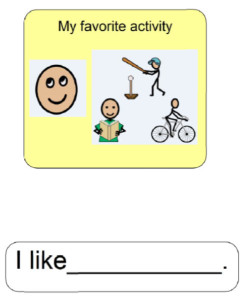 some students need to start communicating successfully! This activity works well with a wide range of students – we have created eye gaze boards or used partner-assisted scanning for students with limited mobility (always remembering to give the choice of “none of these” so we are not limiting their choices!) and have used both low-tech PODD communication books and high-tech AAC devices/apps for those who can direct select.
some students need to start communicating successfully! This activity works well with a wide range of students – we have created eye gaze boards or used partner-assisted scanning for students with limited mobility (always remembering to give the choice of “none of these” so we are not limiting their choices!) and have used both low-tech PODD communication books and high-tech AAC devices/apps for those who can direct select.
Activity: My Book of Favorites
Many of the students we evaluate at our center have certain topics of interest that they enjoy communicating about – a favorite TV show/movie, certain vehicles (trains!), or a favorite kind of music. This book activity is a great way to engage a student in conversation because the topic is something they can relate to – a book all about their favorite things!
Note: “My Book of Favorites” uses a few basic categories that are common to most student but you can always take out certain questions (such as the food question for students who are tube-fed) and add ones that might be more appropriate for your student.
Preparation:
During our intake process we look at the current level of communication that the team has indicated (or that we are able to observe in videos 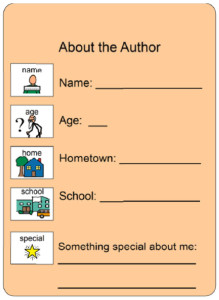 provided by the team) and decide which AAC system(s) we wish to try out with the student during the evaluation process. We then make sure that the relevant information is already available in the system. Any missing vocabulary is then programmed into any of the high-tech AAC systems or added manually to the low-tech communication books that we plan to use. Relevant information for this activity includes:
provided by the team) and decide which AAC system(s) we wish to try out with the student during the evaluation process. We then make sure that the relevant information is already available in the system. Any missing vocabulary is then programmed into any of the high-tech AAC systems or added manually to the low-tech communication books that we plan to use. Relevant information for this activity includes:
- Biographical information about the student: name, age, home town, name of school
- Categorized pages for common colors, animals, foods, and basic age-appropriate activities
- It can also be helpful to add any student-specific ‘favorites’ that might already be known. We have found it very helpful to include a section on our intake form that asks about the student’s specific likes/dislikes.
Most high-quality AAC systems (high-tech OR low-tech) will already have a basic “about me” page that can be quickly updated with the student’s biographical information. These systems will also have basic pre-programmed pages for the other common categories listed above. The need for programming for this activity should be minimal if you are using a robust language system.
Once you have the necessary vocabulary added to the AAC system(s) you are ready to go! See below for links to PDF versions (Boardmaker and Symbolstix symbols) of the “My Book of Favorites” which were created using Boardmaker software.
For this activity it can be very helpful to have a second person to help out the evaluator. We are lucky to have two-person evaluation teams so we have one evaluator acting as the ‘communication partner’ (the person talking with the student) and one evaluator acting as the ‘communication accomplice’ (the person who provides the scaffolding, modeling, and support to the student, as needed).
Description:
We introduce the activity to the student and let them know that we need their help to make an awesome book of all their favorite things! If this is the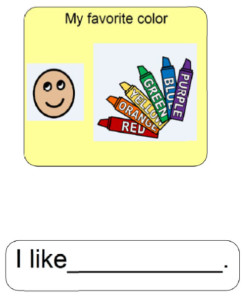 student’s first experience with a particular AAC system (or in some cases, their first exposure to ANY kind of AAC system) we usually encourage them to explore and “play” with the words on the device. We try to provide some natural feedback and Aided Language Stimulation as they explore different pages in the system. For example, “Oh, look! You found the words for different farm animals! I see chicken! I love chickens!” (emphasis on the words that might be modeled on the device).
student’s first experience with a particular AAC system (or in some cases, their first exposure to ANY kind of AAC system) we usually encourage them to explore and “play” with the words on the device. We try to provide some natural feedback and Aided Language Stimulation as they explore different pages in the system. For example, “Oh, look! You found the words for different farm animals! I see chicken! I love chickens!” (emphasis on the words that might be modeled on the device).
Once the student has had some time to explore we start the activity and ask them to help us fill in the information asked in the book. In creating the book we tried to scaffold the questions so that the initial ones are “errorless” (especially when provided with navigational support from the communication accomplice) and the more specific questions come later. For example, the first page of the book asks the student to name their favorite color. Favorite colors can be quite arbitrary and might be different depending on our mood or the day of the week! As my mentor and co-evaluator, Dale Gardner-Fox, likes to say: “The great thing about favorites is that they can change!” Sometimes when we use this activity in an evaluation the student provides an answer to the favorite color and it is not what their parent or teacher was expecting. In this moment, the parent or teacher is not sure if the student gave the right answer. Here’s where we give our “This is not a test, this is communication” spiel and explain that we are going to honor that student’s communication in that moment. Also, by honoring their response and providing authentic feedback (i.e., accepting the response and writing down the answer in their book of favorites) we will sometimes be rewarded by the student self-correcting their response! This alone is a valuable piece of information in the assessment process as it shows us even more of the student’s thought processes and abilities. Exciting stuff right there! And it just goes to show that Dana over at Uncommon Sense has got this one right!
As we move through this activity, the communication accomplice provides a variety of prompts, as needed, while giving the student as much control and autonomy as possible. If the student is demonstrating some ability to navigate through the pages the accomplice will fade the prompts so that we can better assess the student’s capabilities/necessary level of support. The accomplice is also on hand to provide some aided language stimulation support. If the student is unclear about the activity or not inclined to use the AAC system it can be helpful to allow the accomplice/helper to answer the question first and provide a model. Example:
- Communication Partner (to accomplice): “What’s YOUR favorite color?”
- Accomplice: “I like purple!” (emphasis on the single word response modeled on the device)
- Communication Partner (to student): “Dale likes purple! What color do YOU like?”
If the student continues to need some guidance or support we will also pull in other observers in the evaluation (mom, teacher, SLP) and ask them to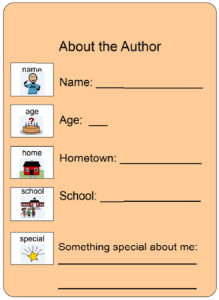 answer using the AAC system so that we can provide multiple models of using the AAC system as an authentic way to communicate. (This can also be a way to provide the parents and other team-members a mini-lesson in aided language stimulation!)
answer using the AAC system so that we can provide multiple models of using the AAC system as an authentic way to communicate. (This can also be a way to provide the parents and other team-members a mini-lesson in aided language stimulation!)
Each of the “favorites” pages are done in a similar fashion until you reach the last page of the book. The last page includes the biographical questions mentioned above. These questions are as specific as the questions get and they really look at the student’s ability to select answers that would be labeled as correct/incorrect. It is helpful to give them a tour of the “about me” page in the system so they can become more familiar with some of the more abstract symbols that might be on this page before they are required to use them to communicate. This can be done in a conversational way with the accomplice (“My name is Jeanne. What is YOUR name?” – with prompts to find the appropriate icon given, as needed). The final question on the page asks the student to say something special about themselves. This is intentionally an open-ended question that can give additional insight into the student’s capabilities. For many students this is not an easy question and they are not quite sure what we are asking of them. But I love this question because sometimes we are blown away by the answers we get. It is a question that allows that student to shine and really show us what they are thinking. We have had students able to tell us they like to play drums, they have a dog, or they like helping in the yard. All things we would not have known about them otherwise!
When we finish the activity we make a copy of the book to give to the student. They can take it home and show their friends and family the book they co-created!
You can click the following links to download the PDF versions (Boardmaker and Symbolstix symbols) of the “My Book of Favorites” I created in Boardmaker or you can co-create a book of favorites with your students using one of the following resources:
— TarHeel Reader Website: Free website! Save finished books/templates digitally online or in PowerPoint or ePUB formats
— Book Creater App: A low-cost app. Save finished book/templates in the app, export in ePUB or PDF. Send books via email to other Book Creator users, or upload to the web in movie format.
— Pictello App: A moderately priced app with very high-quality TTS voices. Save finished books/templates in the app, share with other Pictello users or share in PDF format.
And one more that I have heard good things about and need to spend some quality time learning about this summer!
Feel free to add your favorite resources in the comments section!
:::::::::::::::::::::::::::::::::::::::::
You can download Jeanne’s Book of Favorites in the PCS version and/or the SymbolStix version in the AAC eToolbox.
Filed under: PrAACtical Thinking
Tagged With: assessment, Books, download, Jeanne Tuthill, resources
This post was written by Carole Zangari

